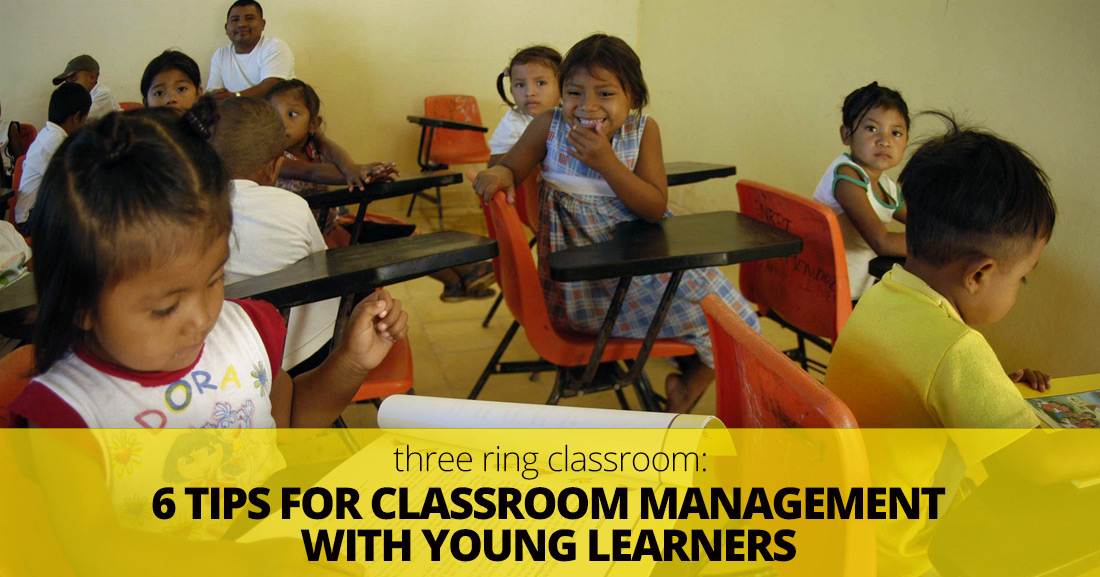Three Ring Classroom: 6 Tips for Classroom Management with Young Learners


It’s not always easy to answer that question. There are several points you need to consider before you can say for sure what the right level of get up and go is for your class. Each class is a little different. They have different needs and abilities. They have different learning styles and levels of energy. With that being said, you are the only one who will be able to determine what level of movement is right for your class. As you are considering the question, here are five things you should keep in mind.
One of the three most common learning styles is learning though movement. Kinesthetic learning is the technical term. Learning through motion, even though it’s one of the most common ways to take in information, is the one least used in classroom environments. It’s easy or at least easier to reach visual learners and auditory (listening) learners through traditional classroom exercises such as book exercises, lectures, and pair work. But when students spend most of their days sitting behind a desk, movement activities are not as natural to include. This means you’ll probably have to be intentional about including movement activities in your lesson plans (unless you happen to be a kinesthetic learner yourself.) That just means you’ll have to ask yourself if you have enough movement activities in your plans at the outset of each lesson and adjust accordingly.
Kids learn through movement. The renowned educator Marie Montessori went so far as to say that kids cannot learn unless they are moving. An entire educational philosophy is based around this idea, and she wasn’t even considering second language learners. If you are teaching a class of younger students, particularly anyone under 13, the younger your students are the more movement they need to have in class. This movement can be games and activities that serve no other purpose than getting them moving, but don’t sell your students short. There are plenty of language learning activities that include movement. So instead of giving your students a minute to stand up and stretch, make the most of their out of desk time by including some language learning element as well.
The more senses that are involved in learning new material, the better students will remember it. This is true for any information, but is even truer of language learning. Movement will activate different areas of the brain, and doing that will make new knowledge more integrated into any student’s mind. In other words, the English your students learn when they move will be connected in more places in their brain, which means they will learn it better. One of the most well-known language teaching methods is total physical response in which language learners associate some type of movement with every bit of the target language they learn. This method is extremely effective. If you don’t know much about the TPR instruction method, it’s worth getting to know more about it and including it in your movement based lesson plans.
If you find that your class is a discipline nightmare, the real issue may be that they are not moving enough as they learn. When classes are too noisy, fidgety, or students get disruptive, it may be time to get everyone up and moving. It’s not that your students have too much energy. It’s that they need constructive, intentional exercises to get that energy out and move their bodies. If you find your class is full of comebacks or won’t follow your directions, try adding more movement activities to class.
Are you afraid of losing control of your class? Do you feel uneasy when your students are up and moving around the classroom? Do you feel like you need to discipline students who get rowdy in class or are disruptive? Do you find yourself coming up with excuses to avoid movement activities, excuses such as there’s not enough room in the classroom, I’ll never get them settled down again, those activities are a waste of time? These are signs that you, the teacher, are afraid of movement activities in class. It’s also a pretty good indication that you need to include more of them in your lesson plans. When teachers have an innate fear of letting their students out from behind the desk, they will of course avoid movement activities. But this kind of resistance probably says more about where you are coming from as a teacher than where your students are truly at.
With all this said, hopefully you have an idea whether you are getting enough movement activities into your lesson plans and then into your classroom. If you want some ideas on how to incorporate move movement into class, here are a couple of truly simple ways to get students moving and learning in class.
If you ever give your students multiple choice or true/false activities, these are easily converted into movement activities. Preset the questions to your class one at a time. You can give them the question and their choices verbally or you can project them on your board. You can also use a combination of the two. Before you ask a question, however, designate a certain area of your room for each answer. If you are giving true/false questions, have one side of each room represent each answer, If you are giving multiple choice questions, label each corner of the room one of the letter answer choices. Then, ask the question and have students move to the appropriate area of the room. You will cover the same material you would otherwise, but your students will get some movement in as they give their answers.
Try putting a target word, person, or idea on each student’s back. Then let them mingle asking yes/no questions of their classmates. Or give them a list of information they need to find and distribute that information throughout the members of the class. Each person will have to talk to their classmates to get the information they need to complete the activity.